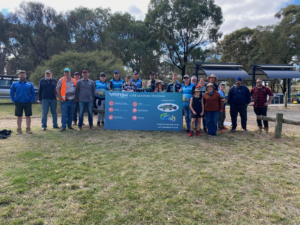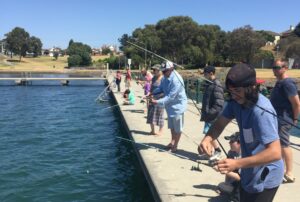July 17, 2018
By Kris Leckie
I was recently invited as a representative of VRFish, along with other recreational fishing stakeholders, to witness and discuss dam desilting operations in the Rubicon and Royston catchments with hydro power operator AGL. Anglers had been approaching us for some time with concerns over the environmental effects the process was potentially having on the health of the river systems, and the timing at which the operation was being carried out. The desilting operation has coincided with the trout closed season for some time, and anglers were particularly concerned about the effects the increased water turbidity may have been having on both trout and native species ability to spawn and reproduce.
HISTORY
The Rubicon hydro scheme was first commissioned in 1928 and consists of 4 power stations that are supplied water via diversion pipes from 3 main dams. The 3 dams (Royston, Rubicon and Rubicon Falls) have a combined storage capacity of 38.4ML. In the first 10 years of operation, the scheme produced on average 17% of the state’s electricity, and was one of the first that was remotely operated in the world. Today, the scheme produces just 0.02% of the state’s electricity, but remains an important part of AGL’s overall hydroelectric scheme that can respond to rapid changes in customer demand, and support the main grid in the event of failures. The historical value of the scheme has been recognized and is heritage listed under the Victorian Heritage Council.

BACKGROUND OF DE-SILTING OPERATIONS
In order for AGL to maintain operational storage volume, and to minimize the amount of sediment that passes through the power stations, accumulated sediment from the bottom of storage dams needs to be flushed regularly. The quantity and nature of sediment varies annually depending on rainfall patterns and catchment conditions, but generally results from a combination of the following factors:
- Natural erosion processes.
- Activities associated with logging and forestry operations within the catchment.
- The network of operational and recreational road and tracks within the catchment.
Prior to the privatization of the state’s electricity assets, the SEC carried out de-silting operations between the 1930’s-1990’s in a largely unregulated fashion during low flow periods, with no consideration given to the potential damage inflicted to the river ecosystem and overall health. However subsequent privatization in the 1990’s resulted in various management agreements being established between key government stakeholders. The agreements covered all activities associated with the operation and maintenance of the Rubicon and Kiewa schemes. This included conditions specifically relating to AGL’s ongoing ability to drain and remove sediment from its storages, and required the company to:
- Prepare a De-Silting Management Plan (DMP) which is to be approved by the minister.
- Review the DMP every 5 years; and
- Annually review its de-silting activities through establishment of a De-Silting Working Group
DE-SILTING WORKING GROUP
In 1997, the De-Silting Working Group was established with the aim to develop and refine an acceptable de-silting regime for the draining and flushing of the storages, and to mitigate or minimize environmental impacts on the downstream river system. The current De-Silting Working Group consists of the following representatives:
- AGL operational staff
- Environmental Protection Agency (EPA)
- Department of Environment, Land, Water and Planning (DELWP)
- North East Catchment Management Authority (NECMA)
- Goulburn Broken Catchment Management Authority (GBCMA)
- Parks Victoria
The De-silting working group meets annually to carry out the following functions:
- Review previous years de-silting activities;
- Review results of turbidity readings taken as part of the water quality monitoring program;
- AGL provide details of inflows into the storages at the time of Desilting activities and estimates of quantities of sediment removed from the storages;
- Discuss timing and intentions for upcoming de-silts;
- Review the aquatic monitoring program; and
- Discuss any other information, concerns, changes or improvements.
The Desilting Management Plan was last approved by Hon. Lily D’Ambrosio, Minister for Energy, Environment and Climate Change on 28 April 2017, following an extensive 6 months of consultation with the Desilting Working Group.
CURRENT DE-SILTING OPERATIONS
Since formation of the working group, and in an effort to reduce environmental impacts on water quality and downstream water users, the timing of desilting was changed to take place during higher inflow periods of late autumn / early winter. The first ‘high inflow’ desilting trial was carried out in conjunction with the EPA and DELWP, and included a comprehensive water quality monitoring program which measured concentrations of suspended solids and turbidity at selected sites upstream and downstream of the storages, along with wide spread macro-invertebrate surveying. Through extensive environmental monitoring and research carried out by the working group, de-silting throughout this period has now proven to be a far more environmentally friendly and practical way to deal with the sediment, and shows that turbidity levels downstream at the Camp Jungai Bridge auto-logger are generally no higher than what average rainfall levels would create.
The monitoring program and establishment of the Desilting Working Group resulted in the implementation of a number of controls including:
- Establishment of a 400 NTU turbidity ‘trigger’ level at the high impact desilting sites (directly below dams). When readings hit 400 NTU the following actions are taken to reduce turbidity levels:
- Cessation of activities within the dam which resulted in the higher readings (i.e. screen cleaning, earthmoving equipment moving sediment); or
- Reducing downstream discharges of highly turbid water by closing the outlet valves.
- Desilting is not carried out until the streamflow at the gauging station at Tumbling Waters on the Rubicon River reach around 10ML/h. Flows of this magnitude create enough natural streamflow to dilute the turbidity levels and minimise impacts downstream;
- Installation of an automatic turbidity monitoring site was installed in the Rubicon River just upstream of Camp Jungai, which measures turbidity levels at 15 minute intervals all year round to assess natural turbidity levels;
- Turbidity levels are taken at ‘control’ and ‘impact’ sites.




WHAT DOES THIS MEAN FOR ANGLERS?
As an avid trout angler and passionate conservationist, I approached this meeting with some reservation, whilst keeping an open mind. Knowing that the Rubicon River is classified as a high priority stream with the GBCMA, I had high hopes that this operation was being managed with the utmost care for the environment possible. And that is exactly the feeling I walked away with after witnessing and discussing the process first hand.
There is no doubt that considerable damage was likely inflicted in the early decades of operation, when little or no regard for the health of the river was considered. And increased logging in the catchment area over many years has no doubt contributed to significantly higher sediment loads being carried into these systems. It would be great if we could do away with dams and barriers to fish migration all together, but it’s important to remember that we have to be able to strike a balance if we are to exist in our modern world. Power generation and a sustainable timber industry within the Rubicon catchment are vitally important to our state’s economy, but unfortunately come with negative impacts. It’s how we manage those impacts that ultimately determines the health of the river and the success of our fishery.
Since the establishment of the De-Silting Working Group, and through extensive environmental monitoring, anglers can rest assured that this process is being carried out under the intense scrutiny of all stakeholders, with the utmost care for the river ecosystem. The Rubicon river has, and will continue to be a fantastic trout fishery for all anglers to enjoy into the future.








